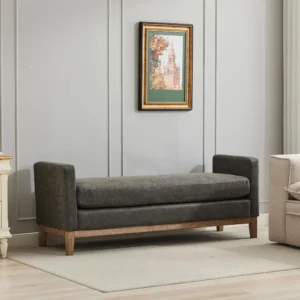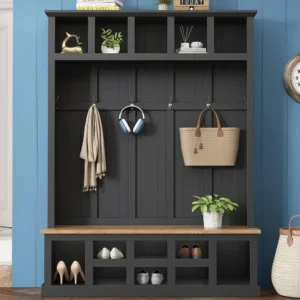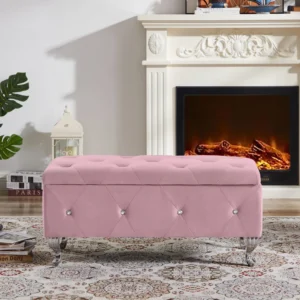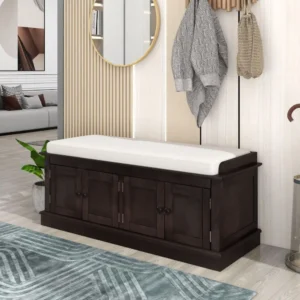1. Why Every Family Home Needs a Well-Designed Mudroom Bench
The humble mudroom bench is far more than just a place to sit while removing shoes. For busy families, it serves as command central for daily comings and goings—a dedicated space that contains chaos and creates order in what would otherwise be an explosion of backpacks, shoes, and outerwear.
Family entryways without proper organization typically face several challenges:
- Piles of shoes blocking walkways
- Coats dropped on the floor instead of hung up
- Missing items during rushed morning departures
- Tracked-in dirt spreading throughout the house
- Nowhere to temporarily place groceries or packages when entering
A thoughtfully designed mudroom bench solves these problems by creating systems that work with your family’s natural habits. The benefits are immediate and significant:
- Smoother, less stressful morning routines
- Easier cleanup and maintenance of your entryway
- Teaching children organization skills through accessible storage
- Containing outdoor elements (mud, snow, rain) before they enter your main living space
- Creating designated places for every family member’s belongings
The difference is remarkable—families report saving up to 15 minutes each morning simply by having an organized system where everything has a place. When children know exactly where their backpacks, shoes, and jackets belong, the daily rush becomes significantly calmer.
Finding the right mudroom bench layout isn’t just about aesthetics—it’s about creating space-saving entryway solutions that match your family’s specific needs, space constraints, and daily habits. The perfect design balances form with function while accommodating everyone from toddlers to teenagers and adults.
2. Assessing Your Family’s Specific Mudroom Needs
Before exploring layout options, take time to evaluate your family’s unique requirements. The most beautiful mudroom bench won’t serve you well if it doesn’t accommodate your actual usage patterns.
Start by considering these key factors:
- Family size and composition: How many people need dedicated storage space? Are there children of different ages with varying abilities to reach hooks and shelves?
- Daily activities: Does your family participate in sports that require equipment storage? Do you have pets that need leash hooks and supply storage?
- Seasonal considerations: How do your storage needs change throughout the year? Will you need space for bulky winter coats or summer beach gear?
- Entry/exit patterns: Does everyone use the same door, or do you need organization systems at multiple entrances?
Create a storage inventory by listing what each family member typically carries:
- Outerwear (coats, jackets, raincoats)
- Footwear (everyday shoes, sports shoes, seasonal boots)
- Bags (backpacks, purses, work bags, gym bags)
- Accessories (hats, gloves, scarves, sunglasses)
- Activity-specific items (sports equipment, musical instruments)
- Pet supplies (leashes, towels for muddy paws)
Consider children’s developmental stages when planning your layout. A mudroom bench that works for your family now should ideally adapt as children grow. Adjustable hook heights and versatile storage solutions make this possible. For younger children, lower hooks encourage independence, while step stools can help them reach slightly higher storage.
The best entry storage benches for families take into account not just current needs but anticipate how those needs will evolve over the next several years. This forward-thinking approach saves you from needing to replace your organization system as your children grow.
3. Space Planning: Measuring and Maximizing Your Entryway
Accurate measurements are the foundation of successful mudroom bench planning. Before falling in love with specific designs, understand exactly what your space can accommodate.
Start with these key measurements:
- Total width of available wall space
- Ceiling height (especially important for vertical storage)
- Depth available without impeding traffic flow
- Door swing clearance needs
- Location of electrical outlets, vents, and switches
A common mistake is underestimating the clearance needed for comfortable movement. Allow at least 36 inches (91 cm) of walkway space in front of your mudroom bench. For bench seating, aim for a height of 18-20 inches (46-51 cm) for comfortable adult use.
For challenging spaces, consider these strategies:
- Narrow hallways: Choose a slimmer bench depth (12-14 inches/30-36 cm) and maximize vertical storage
- Awkward corners: Use L-shaped designs that turn corners effectively
- Limited floor space: Consider wall-mounted options that keep floor clear
- Low ceilings: Focus on lower bench designs with storage underneath rather than tall locker systems
When planning, don’t overlook the vertical dimension. Walls offer valuable real estate for hooks, shelves, and cabinetry. A floor-to-ceiling approach can triple your storage capacity in the same footprint.
Creating a simple scaled drawing of your space can help visualize how different space-saving entryway ideas might work within your constraints. This planning stage is crucial for avoiding costly mistakes and ensuring your chosen layout functions effectively in your actual space.
4. Classic Mudroom Bench Layouts for Different Family Sizes
Different family compositions and space constraints call for different mudroom bench configurations. These classic layouts have proven effective for a variety of family situations:
Straight-Line Bench Layouts
Ideal for: Narrow hallways, smaller families (2-4 people)
– Creates a clean, organized look along a single wall
– Typically 4-8 feet wide (1.2-2.4 meters) depending on family size
– Works well when each family member has one cubby/section
– Offers straightforward DIY potential
L-Shaped Corner Configurations
Ideal for: Medium-sized families (3-5 people), rooms with natural corners
– Maximizes awkward corner spaces that might otherwise be wasted
– Provides more storage without extending too far along any one wall
– Creates a natural division between entry area and adjoining rooms
– Offers flexibility with a longer side for adults and shorter side for children
U-Shaped Designs
Ideal for: Larger families (5+ members), dedicated mudroom spaces
– Creates a separate “room within a room” feel
– Maximum storage capacity with three walls of organization
– Can include a central island or additional seating
– Perfect for homes with heavy traffic and multiple activities
The number of storage sections generally corresponds to family size, plus potentially one extra for guests:
| Family Size | Recommended Storage Sections | Typical Width |
|---|---|---|
| 2-3 members | 3-4 cubbies/lockers | 4-5 ft (1.2-1.5 m) |
| 4-5 members | 5-6 cubbies/lockers | 6-7 ft (1.8-2.1 m) |
| 6+ members | 7+ cubbies/lockers | 8+ ft (2.4+ m) |
When selecting from our collection of mudroom benches, consider how the configuration matches your family’s size and daily routines. For example, a family with young children might prefer open cubbies for easy access, while families with teenagers might appreciate more private, enclosed storage options.
5. Space-Optimized Mudroom Bench Layouts for Small Entryways
Limited space doesn’t mean you must compromise on mudroom functionality. With clever design approaches, even the smallest entryways can accommodate effective organization solutions.
For truly compact spaces, consider these space-maximizing layouts:
- Vertical emphasis designs: When floor space is at a premium, build upward with tall, narrow storage towers flanking a small bench
- Wall-mounted floating benches: Keep floor space open while providing seating and storage above and below
- Corner-optimized triangular benches: Transform awkward corners into functional storage hubs
- Behind-the-door solutions: Utilize often-overlooked space with shallow storage that doesn’t impede door movement
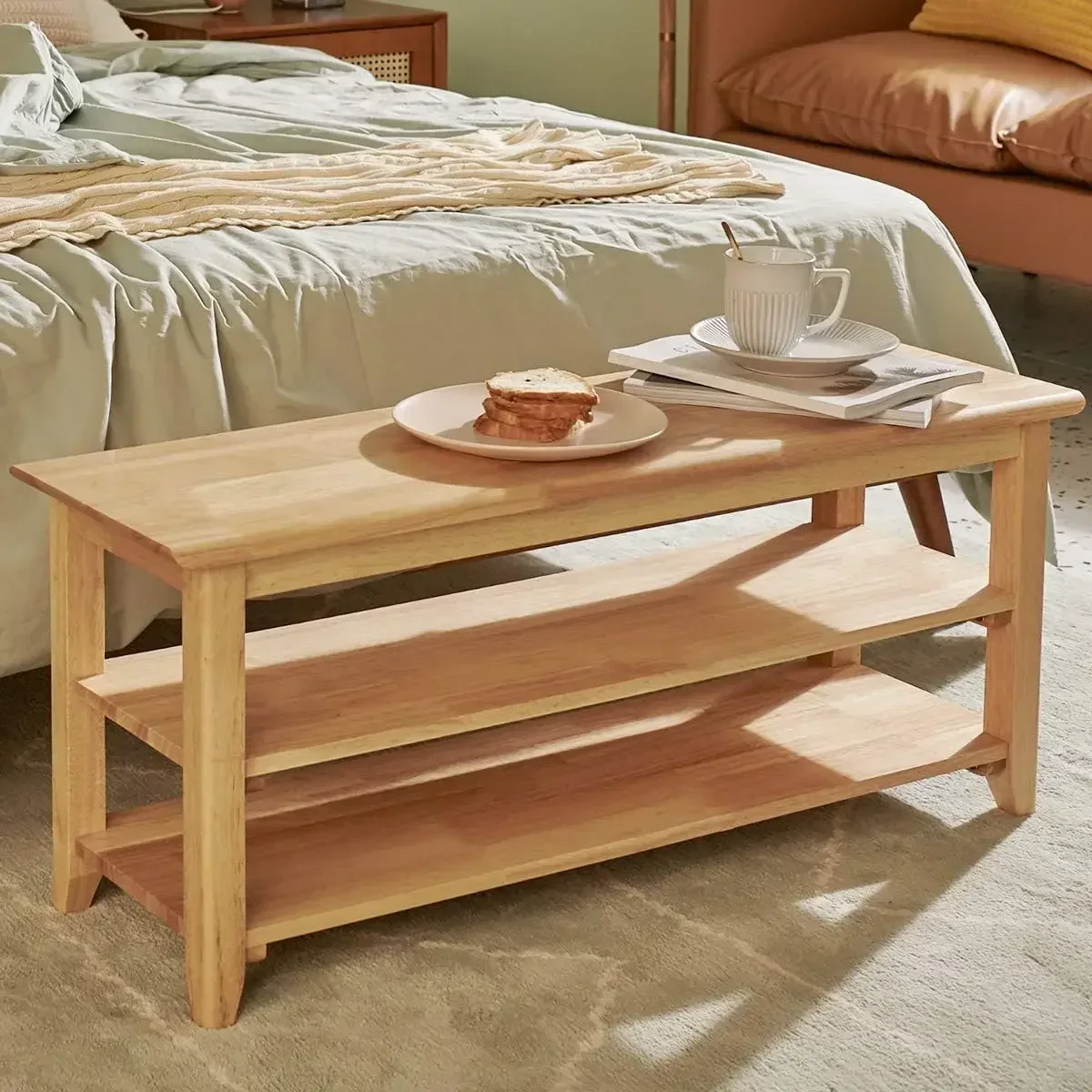
For narrow hallways, consider benches with a depth of just 12-14 inches (30-36 cm) paired with upper cabinets or open shelving of similar depth. This creates a cohesive look while minimizing intrusion into the walkway.
Multi-functional pieces work particularly well in limited spaces:
- Mirror-backed hook panels that serve dual purposes
- Benches with flip-top storage compartments underneath
- Drawer units that double as benches with cushions
- Slim console tables with basket storage and hook panels above
Our collection of small entryway benches offers specialized solutions designed specifically for compact spaces. These pieces are carefully proportioned to provide maximum functionality without overwhelming tight entryways.
Remember that in small spaces, visual clutter can make the area feel even more cramped. Consider closed storage options that hide visual chaos, allowing the space to feel more open and organized.
6. Open vs. Closed Storage Bench Designs: Finding Your Family’s Balance
The debate between open and closed storage isn’t simply about aesthetics—it’s about how your family naturally functions and stays organized. Each approach has distinct advantages and potential drawbacks.
Open Storage Benefits:
- Immediate visibility of items for quick retrieval
- Easier access for children
- Simpler organization with less effort required
- Encourages regular tidying due to visibility
- More affordable and easier to construct
- Creates a casual, accessible feel
Closed Storage Benefits:
- Hides visual clutter for a cleaner appearance
- Protects items from dust and light exposure
- Creates a more formal, finished aesthetic
- Prevents items from falling or being displaced
- Provides greater security for valuable items
- Reduces visual stimulation in busy households
Most successful family mudroom benches incorporate a thoughtful mixture of both styles. Consider which items benefit from visibility (frequently used shoes, daily backpacks) versus those better kept behind doors or drawers (seasonal items, rarely used accessories).
Age is another important factor in this decision. Younger children benefit from open storage where they can easily see and reach their belongings. As children grow older, they may appreciate more private storage for their possessions.
For the ideal balance, many families find success with mudroom bench cubbies that combine open upper compartments for frequently accessed items with closed lower drawers or cabinets for less commonly used belongings. This hybrid approach satisfies both organizational and aesthetic preferences.
7. Individual Stations vs. Shared Storage: Creating Personal Organization Zones
Creating designated personal zones within your mudroom bench layout can transform how your family maintains organization. The choice between individual stations and communal storage significantly impacts daily functionality.
Benefits of Individual Stations:
- Creates clear ownership of spaces and items
- Reduces conflicts over shared space
- Makes it obvious when items are missing
- Teaches children responsibility for their belongings
- Simplifies morning routines with everything in one spot
- Allows customization for different family members’ needs
When designing individual stations, allocate approximately 12-18 inches (30-46 cm) width per person for a comfortable arrangement. Each station typically includes:
- A hook section for coats and bags
- A cubby or shelf for shoes and boots
- Optional drawer or basket for smaller items
- Name label, color coding, or other personalization
Younger children particularly benefit from having clearly defined personal spaces at their height. This approach builds lifelong organizational habits by making it easy to succeed at putting things away.
For shared items like guest coats, umbrellas, or seasonal gear, incorporating some communal storage areas makes sense. These can be positioned at either end of individual stations or in a central location.
Entryway hall trees with divided sections work exceptionally well for creating these individual zones while maintaining a cohesive overall look. They combine vertical storage, hooks, and often bench seating in a unified piece that accommodates the entire family’s storage needs while keeping items separated.
8. Materials and Durability: Choosing Surfaces That Withstand Family Life
The materials you select for your mudroom bench will determine how well it stands up to years of heavy family use. This high-traffic area faces unique challenges: wet boots, muddy sports gear, constant touching, and the occasional backpack toss.
| Material | Durability | Moisture Resistance | Maintenance | Cost |
|---|---|---|---|---|
| Solid hardwood | Excellent | Moderate (needs sealing) | Medium (occasional refinishing) | High |
| Engineered wood/MDF | Good | Good with proper finishing | Low | Moderate |
| Metal (steel/iron) | Excellent | Excellent | Low | Moderate to high |
| Plastic/Composite | Good | Excellent | Minimal | Low to moderate |
| Laminate | Moderate | Good | Very low | Low |
For bench seating surfaces, look for materials that can withstand daily weight and pressure while resisting moisture. Solid wood remains a premium choice for its combination of durability and warmth, though it requires proper sealing in mudroom environments.
Flooring beneath your mudroom bench deserves special consideration. Ideal options include:
- Porcelain or ceramic tile (extremely durable and waterproof)
- Luxury vinyl planks or tiles (waterproof and softer underfoot)
- Sealed concrete (practical and increasingly stylish)
- Indoor/outdoor carpet tiles (replaceable if damaged)
For families with young children or pets, avoid easily damaged materials like unsealed woods or those with delicate finishes. Instead, choose wood mudroom benches with tough polyurethane finishes or washable paint that can handle repeated cleaning.
Hardware quality is another critical consideration that’s often overlooked. Select heavy-duty hinges, drawer slides, and hooks that won’t fail under daily use. Child-friendly features like soft-close hinges can prevent pinched fingers and slamming doors.
9. Storage Components: Essential Elements for Complete Family Organization
Creating an effective family mudroom bench requires thoughtfully combining various storage components. Each element serves a specific purpose in your organization system.
Hook Systems
Hooks form the backbone of vertical storage and should be installed at appropriate heights:
– Adult hooks: 60-72 inches (152-183 cm) from floor
– Teen hooks: 50-60 inches (127-152 cm) from floor
– Child hooks: 30-40 inches (76-102 cm) from floor
Include enough hooks for daily items plus some extras for guests or seasonal gear. Double hooks or multi-tier hook systems maximize vertical storage in the same footprint.
Shoe Storage Solutions
Footwear presents unique storage challenges due to moisture and dirt. Effective options include:
- Open cubbies (8-10 inches/20-25 cm height) with removable washable liners
- Pull-out shoe trays with drainage for wet boots
- Basket systems that allow air circulation
- Tilted shelves that display shoes for easy selection
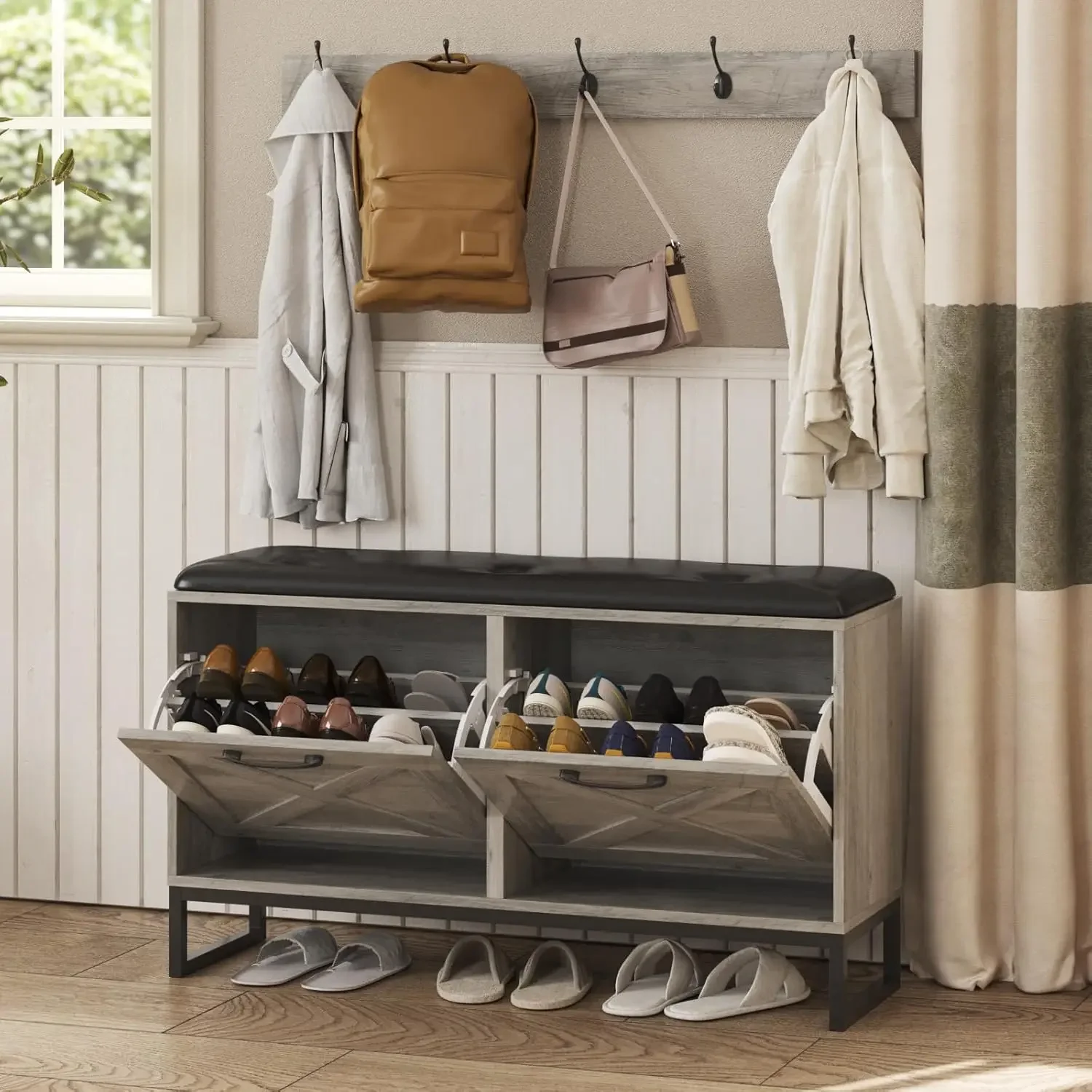
Specialty Storage Elements
Depending on your family’s activities, consider incorporating:
- Drawers for smaller accessories like gloves and hats
- Charging stations for electronics
- Mail organizers for school papers and correspondence
- Sports equipment compartments (ball corrals, racket hooks)
- Hidden storage for valuable items
- Pet supply zones with leash hooks and treat containers
Mudroom benches with shoe storage combine seating with specialized compartments designed specifically for footwear organization. These multi-functional pieces save space while addressing one of the most common entryway clutter sources.
When planning component placement, position frequently used items at easy-reach heights and reserve higher or lower storage areas for seasonal or occasional items. This intuitive organization encourages family members to maintain the system consistently.
10. Multi-Functional Mudroom Bench Layouts for Combined Spaces
Many homes lack a dedicated mudroom, necessitating creative solutions that integrate entryway organization with other functional areas. These hybrid spaces can be equally effective when thoughtfully designed.
For mudroom/laundry combinations, consider:
– Using the bench top as a folding surface
– Installing a hanging rod above the bench for air-drying clothes
– Incorporating a pull-out hamper within the bench structure
– Using the vertical space for both cleaning supplies and outerwear
In living space/entryway combinations:
– Choose bench styles that complement your main living area décor
– Use decorative baskets that hide utilitarian items while looking stylish
– Select cabinet door styles that match other furniture pieces
– Consider furniture-quality finishes rather than utility-focused materials
For mudroom functions in kitchens or dining areas:
– Create a visual divider with different flooring or a area rug
– Use consistent wood tones or paint colors to tie the spaces together
– Select hardware that coordinates with kitchen fixtures
– Scale the mudroom elements appropriately to avoid overwhelming the space
Visual consistency is key in these multi-use areas. Choose materials, colors, and hardware that create harmony between the organizational elements and the room’s primary function.
Organizing a small entryway bench in a multi-functional space requires particular attention to scale and proportion. The bench should provide adequate organization without visually or physically dominating the area. Strategic use of color and material can help the organizational elements either blend in or stand out, depending on your preference.
11. Family-Friendly Aesthetic Approaches: Style That Stands Up to Daily Use
A beautiful mudroom bench is only truly successful if it maintains its appearance through years of family use. Balancing style with practicality requires thoughtful material and design choices.
For family-friendly color schemes, consider:
– Medium tones that hide dirt and scuffs better than very light or very dark finishes
– Two-tone designs with darker, more durable finishes on high-touch areas
– Patterns or textures that camouflage minor marks and imperfections
– Classic colors that won’t quickly feel dated as trends change
Hardware selection significantly impacts both function and style:
– Opt for rounded edges and corners in homes with young children
– Choose oversized hardware that’s easier for small hands to manipulate
– Select finishes that develop character rather than showing wear (oil-rubbed bronze, antique brass)
– Install soft-close mechanisms on drawers and doors to prevent slamming
Incorporate these family-friendly design elements:
– Washable cushions with removable, machine-washable covers
– Replaceable basket liners that can be laundered when dirty
– Scuff-resistant paint finishes or wipeable wallcoverings
– Resilient flooring materials that can handle water and dirt
At Nested Goods, we believe family-friendly design doesn’t mean sacrificing style. Our mudroom bench collections feature thoughtful details like reinforced seams on cushions, protective finishes on wood surfaces, and cleanable materials throughout—all while maintaining the aesthetic quality that elevates your home’s first impression.
12. DIY vs. Pre-Made vs. Custom: Choosing Your Implementation Approach
The right implementation approach depends on your budget, timeline, skills, and specific needs. Each path offers distinct advantages and considerations.
DIY Mudroom Bench Projects
Best for: Those with moderate woodworking skills, budget constraints, or highly specific space requirements
Advantages:
– Typically lowest cost option (approximately $200-600 in materials)
– Completely customizable to your exact space
– Can be built in phases as time and budget allow
– Personal satisfaction of creating a custom solution
Considerations:
– Requires tools, skills, and time (typically 1-3 weekends)
– Quality depends on building experience
– May lack specialized storage features of commercial options
– Usually requires finish maintenance over time
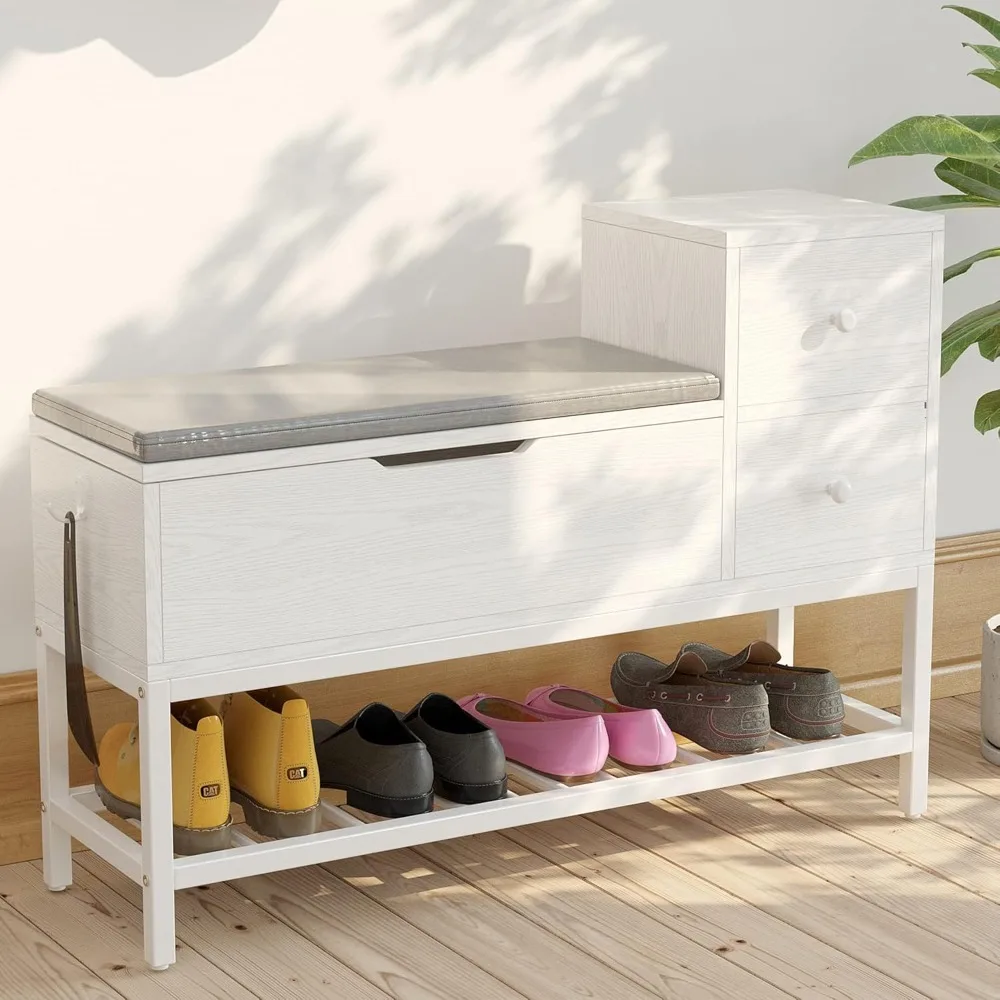
Pre-Manufactured Mudroom Benches
Best for: Those seeking convenience, predictable quality, and faster implementation
Advantages:
– Ready to use with minimal or no assembly
– Consistent, professional finish quality
– Available in numerous styles and configurations
– Typically includes warranty protection
– Can be delivered and installed quickly (days vs. weeks)
Considerations:
– Less customized to your specific space
– Mid-range cost ($500-1500 for quality options)
– Limited flexibility for unusual room dimensions
– May require multiple pieces for larger families
Entryway Bench with Cushion, Mudroom Bench with Cushion, Shoe Bench for Entryway
$1,186.63 Select options This product has multiple variants. The options may be chosen on the product pageBench with Hooks and Storage, Entryway Hall Tree, Mudroom Bench with Cubbies, Mudroom Bench with Shoe Storage
$818.38 Select options This product has multiple variants. The options may be chosen on the product pageModern Entryway Bench, Wood Entryway Bench, Wood Mudroom Bench
$497.69 Select options This product has multiple variants. The options may be chosen on the product pageEntryway Coat Rack Bench, Entryway Hall Tree, Farmhouse Mudroom Bench, Mudroom Bench with Shoe Storage
$805.09 Select options This product has multiple variants. The options may be chosen on the product pageEntryway Bench with Cushion, Small Entryway Bench
$466.79 Select options This product has multiple variants. The options may be chosen on the product pageEntryway Bench with Cushion, Mudroom Bench with Cabinets, Shoe Bench for Entryway, Shoe Bench with Cushion
$991.71 Select options This product has multiple variants. The options may be chosen on the product page
Custom-Built Solutions
Best for: Unusual spaces, specific design aesthetics, or premium built-in appearance
Advantages:
– Perfectly sized to your space with no compromises
– Materials and finishes match existing cabinetry
– Incorporates any specialized features you desire
– Built-in appearance that looks original to home
– Professional installation included
Considerations:
– Highest cost option ($1500-3000+ depending on materials)
– Longer lead time (typically 3-8 weeks)
– Usually not portable if you move
– Requires working with contractors
The best choice often depends not just on budget but on how perfectly the solution needs to fit your space and family needs. Many families start with quality pre-manufactured pieces from collections like ours and supplement with simple DIY accessories for a balanced approach.
13. How to Keep Your Family Mudroom Bench Organized Long-Term
Even the most thoughtfully designed mudroom bench requires maintenance to remain functional. Establishing simple family routines ensures your organization system continues working effectively year after year.
Create sustainable habits with these practical approaches:
- Implement a “one in, one out” policy for seasonal items
- Schedule quick 5-minute reset sessions each evening
- Assign age-appropriate organization responsibilities to children
- Use labels or color-coding for younger family members
- Create a dedicated “lost and found” basket for misplaced items
- Perform seasonal purges of outgrown or unused items
For daily maintenance, establish these simple routines:
– Empty backpacks and lunch boxes completely upon return
– Place dirty sports uniforms directly in laundry
– Hang coats and bags immediately upon entering
– Return shoes to their designated spots
– Wipe down bench surfaces weekly with appropriate cleaners
As children grow, your storage needs will evolve. Plan for periodic reassessment of your system, adjusting hook heights, cubby assignments, and storage types to match your family’s changing needs. The perfect mudroom bench system evolves alongside your family.
Most importantly, be realistic about how your family naturally functions. The most effective organization systems work with your habits rather than trying to force entirely new behaviors. Small adjustments that make organization easier are more sustainable than complete overhauls that feel unnatural.
14. Is a Mudroom Bench Worth the Investment for Your Family?
When considering the value of a mudroom bench investment, look beyond the initial cost to the daily benefits it provides:
- Time savings during hectic morning routines
- Reduced frustration searching for lost items
- Decreased cleaning throughout the house as dirt stays contained
- Lower replacement costs for items that are properly stored
- Improved home organization habits that extend beyond the entryway
- Potential increase in home value, particularly with built-in solutions
For many families, the return on investment becomes apparent within weeks of implementation. Parents report significantly reduced morning stress and fewer lost items once proper storage systems are in place.
If budget constraints make a complete mudroom bench solution impractical, consider these scalable alternatives:
- Start with just the bench and add vertical storage components later
- Use freestanding coat racks paired with simple shoe storage
- Implement a wall-mounted hook system with baskets beneath
- Create temporary solutions with furniture you already own
Remember that organization solutions don’t need to be perfect to be effective. Even simple systems consistently used will outperform elaborate setups that aren’t maintained.
15. Transforming Your Family’s Daily Routine with the Right Mudroom Layout
The right mudroom bench layout does more than organize your belongings—it transforms how your family begins and ends each day. By creating dedicated space for everyday items, you eliminate the daily frustration of searching for essentials and the visual chaos that cluttered entryways create.
When selecting your ideal layout, prioritize function over trends. The most Instagram-worthy mudroom bench fails if it doesn’t accommodate your family’s actual needs and habits. Consider not just today’s requirements but how your storage needs might evolve over the next several years.
Remember that organization is ultimately about making life easier. The best mudroom bench for your family is one that feels intuitive to use and maintains order with minimal effort. It should work with your natural tendencies rather than fighting against them.
At Nested Goods, we understand that beautiful organization transforms not just spaces but experiences. Our mudroom bench collections combine thoughtful functionality with designs that enhance your home’s aesthetic. We believe that when form and function work in harmony, the result is more than just organized space—it’s a more peaceful family life.
Whether you’re working with a dedicated mudroom, a modest entryway, or a multi-function space, the perfect mudroom bench layout exists for your family. With thoughtful planning and the right components, you can create an organized entryway that serves your family beautifully for years to come.


